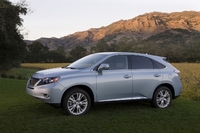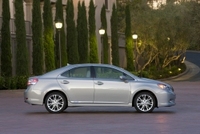2010 Lexus RX 450h and Lexus HS 250h: Two New Hybrids From Lexus
 |
SEE ALSO: Lexus Buyers Guide - Lexus Specs, Prices and Comparisons
By Carey Russ
The Auto Channel
A decade ago, when I first drove a Toyota Prius prototype, I could tell that its gasoline-electric power system would make a fine power source for a luxury car. Even that rather unrefined engineering test car was remarkably smooth and quiet when operating in electric mode with the gasoline engine off. So it came as no surprise when the first Lexus hybrid, based on the popular RX midsize crossover, debuted for 2006. And it was followed by hybrid models of the GS sports sedan and LS premium luxury sedan, to no one's surprise. Hybrids indeed made fine luxury cars.
When the newest RX was introduced in gasoline RX350 form earlier this year, a further upgraded RX450h hybrid also debuted. No surprise. But... There was never a hybrid version of the entry-luxury Lexus ES, interesting as the ES and Toyota Camry, which is available in hybrid form, share many components under the skin. And there never was a Lexus version of the ground-breaking Prius, . So it's now time to welcome the newest Lexus hybrid, the HS 250h.
I've seen and driven both, and offer the following impressions. I'll start with the RX 450h, and then the HS 250h.
2010 Lexus RX 450h
SEE ALSO: 2010 Lexus RX: Reinventing the Vehicle That Invented It All - ROAD TRIP VIDEO
2010 Lexus RX 450h:
The Lexus slogan, "The Relentless Pursuit of Perfection" is not
merely advertising hype. Lexus has obviously been doing something right
with its RX, as the mid-size luxury crossover is its most-popular vehicle,
and the one that has defined the midsize luxury crossover segment since the
debut of the RX 300 back in model year 1999. But there was room for
improvement in both the chassis and powertrain departments, especially with
changing customer demographics. Freshened styling and new interior
technology are also notable.
In looks, the new RX is immediately recognizable as a Lexus RX, but it's leaner and more toned than the previous generation - like it's been working out the old-fashioned way, sans steroids. It embodies the latest in "L-Finesse" lines. The interior is similarly restyled, and convenience and ergonomic efficiency have improved - which was quite a feat considering how good the previous generation was in those respects. The most notable interior feature is the "Remote Touch" controller for the optional navigation system - if you've ever used a computer mouse or trackball, operation really will be almost immediately intuitive. It provides useful tactile feedback. Navigation through the system menus is simple and logical, with no annoyances or surprises.
Drivetrains of both the gasoline V6 RX 350 and gasoline-electric hybrid RX 450h have been upgraded. The 350 gets a bit more power out of its namesake 3..5-liter engine -- five more horsepower and seven more lb-ft of torque -- but that now goes through a six-speed automatic transmission. It's quiet and comfortable on the road, as expected. But when the road gets challenging or there is a need to change direction quickly, the new RX just follows orders, with no excessive roll or resistance to directional change.
Maybe a generation growing up in sport-compacts is making a difference. Lexus does at least as much customer clinic research as anyone, and changes products accordingly. And the new RX has a much better suspension tuning than its forebears, for improved handling and a better driving experience with no reduction of comfort. The rear suspension change, from struts to double wishbones, may get some credit -- as well as extra credit for less intrusion into the cargo area and so increased cabin space -- but revisions in spring and shocks rates and careful matching of all suspension components and use of speed-sensitive electric power steering results in a vehicle that is as responsive as many a sports sedan, with very quick turn-in and minimal body roll even when requested to do an IS-F imitation. No, really! No harshness, no thumpiness, no fuss, no muss... and handling response is also a very important safety factor. The crash you can avoid is one you don't have.
As good as the RX 350 felt on the road, the RX 450h was even better - in both drivetrain response and handling. And that's despite an extra 300 pounds of mass. The previous RX Hybrid had sometimes inconsistent and nonlinear throttle response resulting from changes in power mode. There was a noticeable jolt when the gas engine came on after being stopped at a light or in traffic, and addition of electric motor assist during acceleration sometimes provided more power than anticipated by throttle movement. None of this was serious, or even as bad as the non-response of an old pre-computer era "slushbox" automatic or long-lag turbo from the 80s, but it did preclude the Hybrid from being a true driver's vehicle.
Not now. Because the thumps and jolts are gone. If anything, the Hybrid is smoother than its gasoline-only sibling. And noticeably more powerful as well as more fuel-efficient. X amount of pedal travel gets y amount of acceleration, consistently. No surprises.
What's changed? If the basics of the Lexus/Toyota hybrid system are the same, all details are next-generation and mostly lighter, smaller, and more efficient.
The engine is a derivative of the 3.5-liter V6 in the RX 350, but it runs on the Atkinson cycle (like the Toyota Prius), not the Otto cycle of the old RX 400h. That's more efficient, and further efficiencies come from new exhaust gas recirculation and exhaust heat recovery systems that allow quicker warmup and eliminate the need for fuel enrichment to cool the catalytic converter. The heat recovery system allows the engine to be shut off sooner after a cold start, and more often, too, so it runs in EV mode more, with less fuel use.
An improved flywheel damper is the secret to the smoothness of mode transitions in the system. A two-step torque-absorbing mechanism reduces shocks from engine startup to a negligible amount and is the chief contributor to the RX 450h's driveline refinement.
Power for the hybrid is up, from a combined 268 horsepower to a combined 295. That bests the RX 350's 275. Both versions of the RX come in front- or all-wheel drive form, but AWD systems are different. The RX 350's is a new electronically-activated on-demand system that is lighter and more efficient than previous mechanical systems. As before, the AWD hybrid uses a separate rear motor-generator unit to provide power to the rear wheels when needed.
The 2010 Lexus RX 450h is built in Japan while the 2010 Lexus RX 350 is built in Canada.
The 2010 Lexus RX 450h is available now, with a starting very Base Price of $41,660 in front-wheel drive form or $43,250 with all-wheel drive. Add $875 for shipping and handling and at least $10,000 for popular options(?).
2010 Lexus HS 250h
SEE ALSO: RoadTrip: New Lexus HS 250h Luxury Vehicle
2010 Lexus HS 250h:
And now for something completely different, the first dedicated
luxury hybrid. Did someone say "cover all the bases"? Must have been
someone at Lexus, as the HS is the company's third "entry-level" car after
the comfort-oriented ES and the sporty IS. Why? Market research again.
People who could afford luxury cars bought Priuses because they were
hybrids. While that "eco-chic" did no harm to the Prius's reputation, the
hybrid cause, or to Toyota's bottom line, would they possibly be happier in
a better-equipped, quieter, more luxurious Lexus? Enough queried said
"yes", and the HS 250h, soon to be released, is the result.
Logically, since the Lexus ES 350 and Toyota Camry share underpinnings one would think that the entry Lexus hybrid would be based on the ES. Humans aren't necessarily logical, and the Camry Hybrid's drivetrain could be a bit overwhelmed when moving a heavier Lexus. Luxury adds weight in the form of more soundproofing and more features and more comfort...
Why not a fancier Prius? The Prius is a Toyota icon, not Lexus. It shouldn't take an MBA in marketing to see the error there... Toyota, being a worldwide manufacturer, had something smaller and lighter than a Camry/ES but different from the Prius. It's a European model called the Avensis, and it donated chassis parts to the HS cause, but no body or interior bits.
Make no mistake, the HS is every bit a Lexus, but with a green touch. In addition to the latest generation of hybrid drivetrain, it features use of recycled materials, ecologically-oriented plastics, and all of the luxury features and gadgets any Lexus buyer could think of as standard or optional equipment except maybe the long-wheelbase LS's reclining vibro-massage rear seat.
New driver-aiding technologies include the Enform™ telematics system, a heads-up display (also in the RX), intelligent high beams, and the wide-view front monitor. Of these, the front monitor is the most interesting, as the others have, in some form, been available from other manufacturers for years. Plus I have occasion to creep out into traffic from spots with poor side visibility and trust oncoming drivers to avoid me. I'm not a trusting person at that point...
The front monitor system uses a wide-angle camera mounted in the grille, under the Lexus logo. It displays its image on the navigation system monitor (so, yes, the car must be equipped with the nav system). What the driver sees is what he or she otherwise may not, if for instance coming out of a garage or at a stop sign on a road with limited side visibility back at the driver's eyepoint. It works at speeds under 7.5 mph, and is a fine complement to the rear-view camera.
Exterior styling is definably Lexus. Like many small cars today, the proportions are shorter, narrower, and higher than those of its larger siblings. Think baby Lexus, although it is actually longer than the IS or any of its German competitors. The flowing lines are functional, as the shape and careful management of air under the car contribute to low aerodynamic drag for improved fuel economy and lower noise levels.
So interior space won't be an issue -- and the interior is the HS's most interesting part. This is definitely a car for the high-tech set. Think "interface" - with the exception of the steering wheel, the cockpit could be on the bridge of a spaceship. Most unusual is the "console", cantilevered out from the dash instead of attached to the floor. Atop it, if the nav system is fitted, is the same computer mouse-like controller as is found in the newest RX. It's just as useful, and because of its high position, it gives an impression that is more "in front of a computer" than "driving a car". The shift lever, as is common in modern cars, is not mechanically connected to the transmission. Here, that's a plus, and if driving the HS feels like being in a very realistic simulator, perhaps that's what Lexus had in mind.
Comfort? The HS 250h is a Lexus, and so it coddles its occupants with all the comfort and safety expected. And it has the biggest trunk of any Lexus hybrid, and the biggest trunk opening of any Lexus sedan. Performance? Considering its mission and content, not bad at all.
Under the HS's hood is similar to what is found in the Camry Hybrid, a 147-horsepower 2.4-liter Atkinson cycle four-cylinder engine matched with a 140-hp traction motor for a maximum combined output to the front wheels of 187 hp. As in other Toyota series/parallel hybrids, the starter motor does multiple duty as the generator and CVT transmission controller, and the traction motor recharges the 244.8-volt NiMH battery pack during regenerative braking. With a near 3700-pound curb weight, same as the Camry Hybrid, acceleration is similar at 8.4 seconds for 0-60. So everyday merging situations should be no problem. Fuel economy, at EPA 35 city, 33 highway, and 34 combined, is also nearly identical with the Camry Hybrid.
Driving impressions? Not extensive, as what driving was done during the introduction was short loops around congested city streets of Orange County, CA, just south of Los Angeles and I had to pay attention to directions so as not to get lost. I can say that the HS drives like any new-generation Toyota hybrid, which is to say smoothly. The suspension is more refined that that of the Camry Hybrid, and interior noise levels expectedly lower. Acceleration is perfectly adequate for daily use and the regenerative braking plus four-wheel antilock discs with Brake Assist and VSC stability control ensure quick stops. If the fuel economy is not up to Prius standards, even hybrids have to obey the laws of physics. The HS is larger, heavier, and more powerful than a Prius. That means more fuel. Such is the price of (hybrid) luxury. Mid-30s is not exactly poor mileage...
The 2010 Lexus HS 250h went sale in late August 2009, with prices starting at $34,200 for the base model and $36,970 for the Premium. Add an $875 delivery fee.
SEE ALSO: Lexus Buyers Guide - Lexus Specs, Prices and Comparisons




